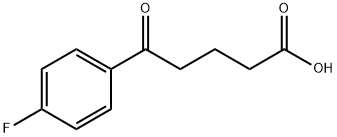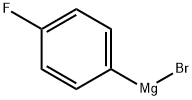
4-(4-Fluorobenzoyl)butyric acid synthesis
- Product Name:4-(4-Fluorobenzoyl)butyric acid
- CAS Number:149437-76-3
- Molecular formula:C11H11FO3
- Molecular Weight:210.2

108-55-4

462-06-6

149437-76-3
4-(4-Fluorobenzoyl)butyric acid was synthesized as follows: 250 g of anhydrous AlCl3 (1.87 mol) and 300 mL of fluorobenzene (307.5 g; 3.2 mol) were added to a 2 L three-necked round-bottomed flask, and the mixture was cooled to 5 °C in an ice bath. A turbid suspension of 100 g of glutaric anhydride (0.86 mol) dissolved in 400 mL of fluorobenzene (4.3 mol) was slowly added through the addition funnel over 45 min, keeping the reaction temperature below 12 °C. The reaction mixture was gradually warmed to room temperature and stirred for 90 min and the completion of the reaction was monitored by NMR. The reaction mixture was cooled to 0 to 5 °C and 700 mL of a cold aqueous solution of 1N HCl was carefully added to quench unreacted AlCl3, keeping the temperature below 20 °C initially and not exceeding 40 °C later. The mixture was poured into 2 L of a 1:1 mixture of water and ice (v/w) to precipitate the crude product, and the white suspension was filtered and washed well with water. The white solid was dissolved in 3 L of 5% NaHCO3 saturated aqueous solution, heated in a steam bath for 1 h and then filtered through a diatomaceous earth pad while hot. The filtrate was cooled to room temperature, adjusted to pH 1 by adding about 320 mL of concentrated HCl drop by drop, the product crystallized and stirred in an ice bath for 30 minutes. Filtered, the wet filter cake was washed with ice-cold water and dried under vacuum at 50 °C for 16 h. 143.2 g of 4-(4-fluorobenzoyl)butyric acid was obtained with a melting point of 141 to 142 °C and a yield of 79.3%.

108-55-4
450 suppliers
$6.00/25g

462-06-6
432 suppliers
$10.00/5g

149437-76-3
374 suppliers
$8.00/10g
Yield:149437-76-3 95%
Reaction Conditions:
with hydrogenchloride;aluminum (III) chloride in dichloromethane;water at 0; for 0.25 h;Friedel-Crafts Acylation;
Steps:
1.1; 1.2; 1.3; 1.4 Example 1:
(1) Glutaric anhydride (compound 2) and fluorobenzene (compound 1) are uniformly mixed to obtain a homogeneous A solution. The concentration of glutaric anhydride (compound 2) in the homogeneous A solution is 1.5 mol/L. (2) Anhydrous aluminum trichloride, fluorobenzene (compound 1) and dichloromethane are mixed uniformly to obtain a homogeneous B solution. The concentration of aluminum trichloride in the homogeneous B solution is 0.75 mol/L. The molar ratio of aluminum to fluorobenzene (compound 1) is 1:1.7. (3) Dilute concentrated hydrochloric acid with water to make C solution, the concentration of hydrochloric acid in C solution is 1mol/L. (4) The first micro-reaction mixer M1 and the first reaction module L1 are both placed at a preset temperature, and the homogeneous A solution obtained in step (1) and the homogeneous B solution obtained in step (2) are combined The first advection pump P1 and the second advection pump P2 are respectively pumped into the first micro-reaction mixer M1 according to the flow rate ratio (1:2), and the first advection pump P1 pumps the above homogeneous A solution into the first micro-reaction mixing In the reactor M1, the flow rate is 0.2mL/min, and the mixture is evenly mixed and transferred to the first reaction module L1 (inner diameter: 0.1mm, length: 20m) for Friedel-Crafts acylation reaction. The reaction temperature is 0°C and the reaction time is 15min. The second micro-reaction mixer M2 and the second reaction module L2 are also placed at a preset temperature. After the Friedel-Crafts acylation reaction is completed, the obtained reaction solution (labeled as D reaction solution) is pumped into the second In the reaction mixer M2, the flow rate is 0.1mL/min, and at the same time, the C solution is pumped into the second reaction mixer by the third advection pump P3 according to the flow rate ratio (2:1) of the above D reaction solution. In M2, the mixture is uniformly mixed and transferred to the second reaction module L2 (inner diameter: 1 mm, length: 5 m) for quenching reaction, the reaction temperature is 0° C., and the reaction time is 10 min. The reaction liquid obtained after the quenching reaction is pumped into the receiving reactor R, Stir for 5 minutes, flow out through the liquid outlet O, and collect in the liquid separator, Let stand for liquid separation, extract the upper aqueous phase with dichloromethane, combine the organic phases, Add an equal volume of saturated sodium carbonate solution to alkalize, extract and separate liquids, The resulting aqueous phase was acidified with concentrated hydrochloric acid to its pH value of 1. After extracting the aqueous phase with dichloromethane, the organic phases were combined, Wash with saturated brine, dry with anhydrous sodium sulfate, filter with suction, After concentration under reduced pressure, vacuum drying for 12h at 35, 4-(4-fluorobenzoyl)butyric acid was obtained as a white solid with a yield of 95%.
References:
CN112778117,2021,A Location in patent:Paragraph 0041-0046

53715-97-2
0 suppliers
inquiry

149437-76-3
374 suppliers
$8.00/10g

108-55-4
450 suppliers
$6.00/25g

352-13-6
197 suppliers
$40.00/50mL

149437-76-3
374 suppliers
$8.00/10g